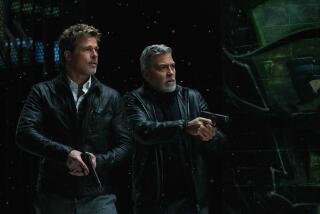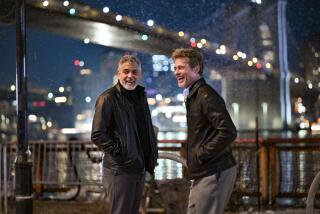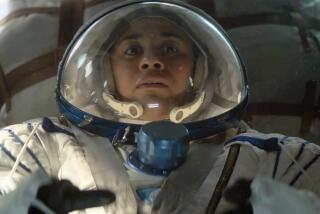Review: In ‘The Midnight Sky,’ a grizzled George Clooney considers the end of the world
- Share via
It may be the unique circumstances in which we are living, but it feels like every movie released in 2020 turns out to be about subsistence. Right until the final light is extinguished (or the final fade to black), it’s all about getting by as best we can, for as long as that may be.
“The Midnight Sky,” directed by and starring George Clooney, is no different. Adapted by Mark L. Smith (“The Revenant”) from Lily Brooks-Dalton’s novel “Good Morning, Midnight,” the film places Clooney, as accomplished astronomer Augustine Lofthouse, in the midst of a global cataclysm in the year 2049. The end is indeed nigh.
We first meet Augustine at the Barbeau Observatory in the Arctic Circle, three weeks after his colleagues and their families were evacuated by helicopter. Suffering from an unnamed terminal illness that requires regular blood transfusions, the astronomer remains behind, shuffling through his days, monitoring the airwaves for signs of life. We quickly learn that beyond the polar regions, it is unlikely anyone else has survived this catastrophic event (also unnamed) and his colleagues are all likely dead. In these final days, Augustine remembers key moments when he chose his career over living and loving, a profound dissatisfaction infecting his mood.
The observatory’s communication system informs Augustine that the NASA spaceship Aether, returning from a two-year mission exploring K23, a possibly inhabitable moon of Jupiter, will soon be within satellite range. He realizes he must do everything he can to contact them and warn them of Earth’s imminent demise.
Meanwhile, Augustine discovers a young girl named Iris (Caoilinn Springall), apparently left behind after the evacuation, hiding in the observatory’s kitchen. Unable or unwilling to speak, Iris presents the cantankerous Augustine with an unwanted companion and the film an expedient narrative device.
Aboard the Aether, we are introduced to the crew: Felicity Jones as comms specialist Sully, David Oyelowo as Commander Adewole, Kyle Chandler as pilot Tom Mitchell, Demián Bichir as navigation specialist Sanchez and Tiffany Boone as Maya, the flight engineer.
At this point, the movie essentially separates into two distinct stories — with the Aether crew desperately attempting to figure out why it has been unable to communicate with Earth and Augustine trying to contact them. Realizing that the observatory’s antenna is too weak to make the connection, he decides to take Iris and try to reach a weather station further north by snowmobile.
The journey is suitably treacherous and provides the film’s most dynamic sequences. It’s involving enough that it’s easy to forget about the plight of the Aether, which, truth be told, isn’t all that compelling. Despite the strong cast and the fact that Sully is pregnant, this portion of the story follows the path of countless forgettable space dramas. By the time we return to Augustine and Earth, “The Midnight Sky” has lost precious dramatic momentum.
That’s primarily due to losing touch with Augustine. Clooney is good at playing the reluctant hero and easily slips into Augustine’s shaggy beard and illness-worn body. The emotional thaw that comes from his relationship with Iris, though entirely predictable, is nevertheless deeply reflected in his character’s face. Unfortunately, that connection is sacrificed to the time spent aboard the Aether — a narrative imperative essential for the movie to reach its maddeningly contrived ending.
There was a lot of promise in “The Midnight Sky.” Augustine’s odyssey had great potential. The work that so fascinated him that he sacrificed all else is glimpsed, but we hear only snatches of why it was so important. The film’s themes of extinction and survival are worthy of thoughtful treatment, something that eludes the ambitious movie as it succumbs to a schematic and sentimental telling that overreaches for a grand gesture and obscures the more meaningful ideas.
‘The Midnight Sky’
Rated: PG-13, for some bloody images and brief strong language
Running time: 2 hours, 5 minutes
Playing: Available Dec. 23 on Netflix
More to Read
Only good movies
Get the Indie Focus newsletter, Mark Olsen's weekly guide to the world of cinema.
You may occasionally receive promotional content from the Los Angeles Times.











